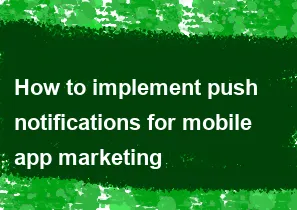How to implement push notifications for mobile app marketing

Implementing push notifications for mobile app marketing involves a combination of server-side and client-side development. Here's a general guide to help you get started:
Server-Side Implementation:
Set up a Push Notification Service:
- Choose a push notification service provider, such as Firebase Cloud Messaging (FCM) for Android and iOS, or Apple Push Notification Service (APNs) for iOS.
- Create an account on the chosen platform and set up a new project.
Configure Your App with the Push Notification Service:
- Obtain API keys, credentials, and other necessary information from the push notification service.
- Integrate these credentials into your mobile app server to enable communication with the push notification service.
Implement a Server-Side API:
- Develop an API on your server to trigger push notifications.
- The API should accept relevant data such as the device token, message content, and other optional parameters.
Client-Side Implementation:
Integrate Push Notification SDK:
- Integrate the push notification SDK provided by the chosen service into your mobile app.
- For example, use the Firebase SDK for Android and iOS.
Register for Push Notifications:
- When a user installs your app, request their permission to receive push notifications.
- Register the device with the push notification service and obtain a unique device token.
Handle Push Notification Events:
- Implement handlers to process various push notification events, such as receiving a notification, tapping on a notification, or dismissing a notification.
- Customize the behavior based on the user's interaction with the notification.
Send Device Token to Your Server:
- Send the device token obtained from the push notification service to your server.
- Store this token for future use when sending targeted push notifications.
Implementing Push Notifications in Marketing:
Segment Your Audience:
- Use the data collected from your app to segment your audience based on user behavior, preferences, or demographics.
Personalize Messages:
- Craft personalized and relevant push notification messages for each user segment.
- Utilize user data to tailor notifications to individual preferences.
Schedule Push Notifications:
- Choose optimal times to send push notifications, considering the time zones and habits of your target audience.
- Avoid sending too many notifications to prevent user annoyance.
Monitor and Analyze Performance:
- Use analytics tools provided by the push notification service to monitor the performance of your campaigns.
- Analyze metrics such as open rates, click-through rates, and conversion rates to refine your marketing strategy.
Optimize Over Time:
- Continuously optimize your push notification strategy based on user feedback and performance metrics.
- A/B testing can be valuable to identify the most effective messaging and timing.
Remember to respect user privacy and adhere to relevant regulations, such as GDPR for European users. Always provide users with the option to opt-out of push notifications if they wish to do so.
-
Popular Post
- How to optimize for Google's About This Result feature for local businesses
- How to implement multi-language support in an Express.js application
- How to handle and optimize for changes in mobile search behavior
- How to handle CORS in a Node.js application
- How to use Vue.js with a UI framework (e.g., Vuetify, Element UI)
- How to configure Laravel Telescope for monitoring and profiling API requests
- How to create a command-line tool using the Commander.js library in Node.js
- How to implement code splitting in a React.js application
- How to use the AWS SDK for Node.js to interact with various AWS services
- How to use the Node.js Stream API for efficient data processing
- How to implement a cookie parser middleware in Node.js
- How to implement WebSockets for real-time communication in React
-
Latest Post
- How to implement a dynamic form with dynamic field styling based on user input in Next.js
- How to create a custom hook for handling user interactions with the browser's device motion in Next.js
- How to create a custom hook for handling user interactions with the browser's battery status in Next.js
- How to implement a dynamic form with dynamic field visibility based on user input in Next.js
- How to implement a dynamic form with real-time collaboration features in Next.js
- How to create a custom hook for handling user interactions with the browser's media devices in Next.js
- How to use the useSWRInfinite hook for paginating data with a custom loading indicator in Next.js
- How to create a custom hook for handling user interactions with the browser's network status in Next.js
- How to create a custom hook for handling user interactions with the browser's location in Next.js
- How to implement a dynamic form with multi-language support in Next.js
- How to create a custom hook for handling user interactions with the browser's ambient light sensor in Next.js
- How to use the useHover hook for creating interactive image zoom effects in Next.js